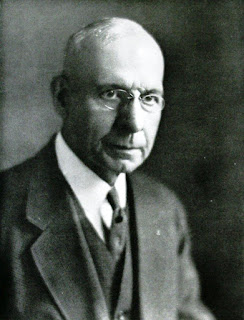Louis Sullivan, ca. 1923. From "Louis H. Sullivan
(1856-1924," Architectural Record, June, 1924, p. 587.
Poet Marge Piercy penned the very powerful poem "Visiting a Dead Man on a Summer Day." It is about Louis Sullivan's tragic life, his tombstone and his Getty Tomb at Graceland Cemetery and was written in Chicago during the rioting across the U.S. during the dreadful summer of 1967.
"Visiting a dead man on a summer day"
by Marge Piercy
In flat America, in Chicago,
Graceland cemetery on the German North Side.
Forty feet of Corinthian candle
celebrate Pullman embedded
lonely raisin in a cake of concrete.
The Potter Palmers float
in an island parthenon.
Barons of hogfat, railroads and wheat
are postmarked with angels and lambs.
But the Getty tomb: white, snow patterned
in a triangle of trees swims dappled with leaf shadow,
sketched light arch within arch
delicate as fingernail moons.
The green doors should not be locked.
Doors of fern and flower should not be shut.
Louis Sullivan, I sit on your grave.
It is not now good weather for prophets.
Sun eddies on the steelsmoke air like sinking honey.
On the inner green door of the Getty tomb
(a thighbone's throw from your stone)
a marvel of growing, blooming, thrusting into seed:
how all living wreathe and insinuate
in the circlet of repetition that never repeats:
ever new birth never rebirth.
Each tide pool microcosm spiraling from your hand.
Sullivan, you had another five years
when your society would give you work.
Thirty years with want crackling in your hands.
Thirty after years with cities
flowering and turning grey in your beard.
All poets are unemployed nowadays.
My country marches in its sleep.
The past structures a heavy mausoleum
hiding its iron frame in masonry.
Men burn like grass
while armies grow.
Thirty years in the vast rumbling gut
of this society you stormed
to be used, screamed
no louder than any other breaking voice.
The waste of a good man
bleeds the future that's come
in Chicago, in flat America,
where the poor still bleed from the teeth,
housed in sewers and filing cabinets,
where prophets may spit into the wind
till anger sleets their eyes shut,
where this house that dances the seasons
and the braid of all living
and the joy of a man making his new good thing
is strange, irrelevant as a meteor,
in Chicago, in flat America
in this year of our burning.
(Marge Piercy, “Visiting a dead man on a summer day” from Circles
on the Water: Selected Poems of Marge Piercy (New York: Alfred A. Knopf,
1982). First appeared in Carleton Miscellany (Winter 1967). Copyright
© 1967, 1982 by Marge Piercy and Middlemarsh, Inc. Used by permission of the Wallace
Literary Agency, Inc.
I like to think that Piercy derived her inspiration for this piece after discovering Sullivan's "Wherefore the Poet?" published by Harriet Monroe in the March 1916 issue of Poetry: A Magazine of Verse.
John Wellborn Root, Architect by Harriet Monroe, Prairies School Press, 1966. (Originally published in 1896 by Houghton-Mifflin).
Sullivan was certainly well-acquainted with the editor of Poetry: A Magazine of Verse Harriet Monroe through her biography of her brother-in-law John Wellborn Root, her architectural articles for the Chicago Tribune and socially. He also certainly would have seen Monroe read her "Columbian Ode" at the opening ceremony of World's Columbian Exposition in 1893. The seeds of what Sullivan thought the impact of the "classic" architecture of the Exposition might have on the progression of modern architecture might have been planted while he was listening to Monroe's opus,
"Meanwhile the virus of the World's Fair, after a period of incubation ... began to show unmistakable signs of the nature of the contagion. There came a violent outbreak of the Classic and the Renaissance in the East, which slowly spread Westward, contaminating all that it touched, both at its source and outward.... By the time the market had been saturated, all sense of reality was gone. In its place, had come deep seated illusions, hallucinations, absence of pupillary reaction to light, absence of knee-reaction-symptoms all of progressive cerebral meningitis; the blanketing of the brain. Thus Architecture died in the land of the free and the home of the brave.... The damage wrought by the World's Fair will last for half a century from its date, if not longer." (The Autobiography of an Ideaby Louis Sullivan). (Author's note: For much more on Sullivan and his impact on Adolf Loos, Frank Lloyd Wright, R. M. Schindler and Richard Neutra see my "R. M. Schindler, Richard Neutra and Louis Sullivan's"Kindergarten Chats").
Harriet Monroe at her desk in the office of Poetry: A Magazine of Verse, 1914.
The Columbian Ode by Harriet Monroe, W. Irving Way and Co., Chicago, 1893.
The 1967 publication of Piercy's poignant poem on the tragic life of Sullivan brought full-circle Monroe's publication of his "Wherefore the Poet?" when Frank Lloyd Wright's beloved Liebermeister's career was languishing in 1916.
Poetry: A Magazine of Verse, March 1916.
Monroe was quite stricken with Sullivan's regard for poetry and the poets who write it. His closing line is one to remember,
"Awake! O Multitudes; for poetry is the highest of practical powers. It is not what you have supposed. Awake!"








